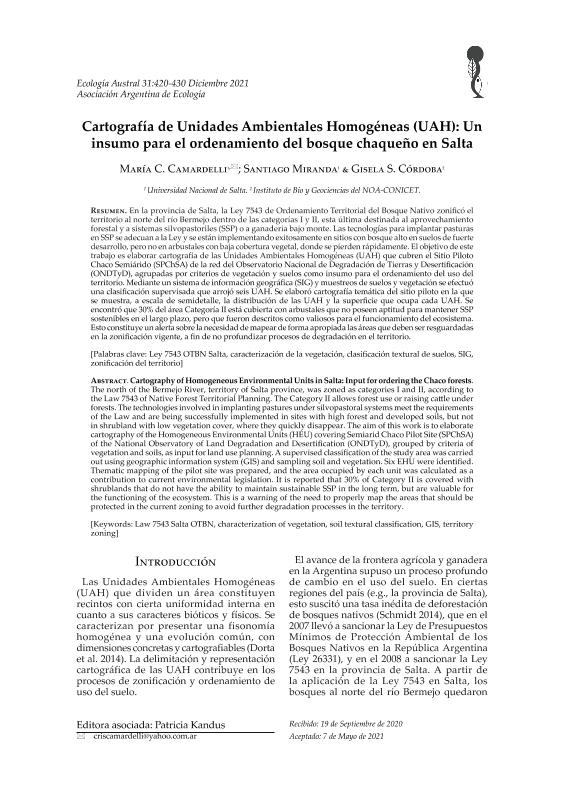Artículo
En la provincia de Salta, la Ley 7543 de Ordenamiento Territorial del Bosque Nativo zonificó el territorio al norte del río Bermejo dentro de las categorías I y II, esta última destinada al aprovechamiento forestal y a sistemas silvopastoriles (SSP) o a ganadería bajo monte. Las tecnologías para implantar pasturas en SSP se adecuan a la Ley y se están implementando exitosamente en sitios con bosque alto en suelos de fuerte desarrollo, pero no en arbustales con baja cobertura vegetal, donde se pierden rápidamente. El objetivo de este trabajo es elaborar cartografía de las Unidades Ambientales Homogéneas (UAH) que cubren el Sitio Piloto Chaco Semiárido (SPChSA) de la red del Observatorio Nacional de Degradación de Tierras y Desertificación (ONDTyD), agrupadas por criterios de vegetación y suelos como insumo para el ordenamiento del uso del territorio. Mediante un sistema de información geográfica (SIG) y muestreos de suelos y vegetación se efectuó una clasificación supervisada que arrojó seis UAH. Se elaboró cartografía temática del sitio piloto en la que se muestra, a escala de semidetalle, la distribución de las UAH y la superficie que ocupa cada UAH. Se encontró que 30% del área Categoría II está cubierta con arbustales que no poseen aptitud para mantener SSP sostenibles en el largo plazo, pero que fueron descritos como valiosos para el funcionamiento del ecosistema. Esto constituye un alerta sobre la necesidad de mapear de forma apropiada las áreas que deben ser resguardadas en la zonificación vigente, a fin de no profundizar procesos de degradación en el territorio. The north of the Bermejo River, territory of Salta province, was zoned as categories I and II, according to the Law 7543 of Native Forest Territorial Planning. The Category II allows forest use or raising ca�le under forests. The technologies involved in implanting pastures under silvopastoral systems meet the requirements of the Law and are being successfully implemented in sites with high forest and developed soils, but not in shrubland with low vegetation cover, where they quickly disappear. The aim of this work is to elaborate cartography of the Homogeneous Environmental Units (HEU) covering Semiarid Chaco Pilot Site (SPChSA) of the National Observatory of Land Degradation and Desertification (ONDTyD), grouped by criteria of vegetation and soils, as input for land use planning. A supervised classification of the study area was carried out using geographic information system (GIS) and sampling soil and vegetation. Six EHU were identified. Thematic mapping of the pilot site was prepared, and the area occupied by each unit was calculated as a contribution to current environmental legislation. It is reported that 30% of Category II is covered with shrublands that do not have the ability to maintain sustainable SSP in the long term, but are valuable for the functioning of the ecosystem. This is a warning of the need to properly map the areas that should be protected in the current zoning to avoid further degradation processes in the territory.
Cartografía de Unidades Ambientales Homogéneas (UAH): Un insumo para el ordenamiento del bosque chaqueño en Salta
Título:
Cartography of Homogeneous Environmental Units in Salta: Input for ordering the Chaco forests
Fecha de publicación:
12/2021
Editorial:
Asociación Argentina de Ecología
Revista:
Ecología Austral
ISSN:
0327-5477
Idioma:
Español
Tipo de recurso:
Artículo publicado
Clasificación temática:
Resumen
Archivos asociados
Licencia
Identificadores
Colecciones
Articulos(IBIGEO)
Articulos de INST.DE BIO Y GEOCIENCIAS DEL NOA
Articulos de INST.DE BIO Y GEOCIENCIAS DEL NOA
Citación
Camardelli, María Cristina; Miranda, Santiago Rubén; Córdoba, Gisela Soledad; Cartografía de Unidades Ambientales Homogéneas (UAH): Un insumo para el ordenamiento del bosque chaqueño en Salta; Asociación Argentina de Ecología; Ecología Austral; 31; 12-2021; 420-430
Compartir




